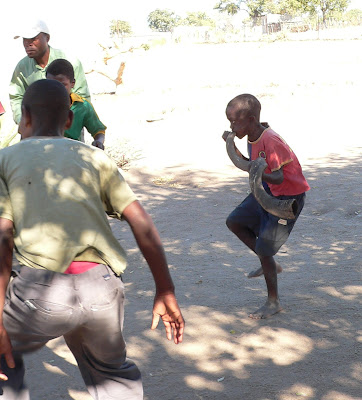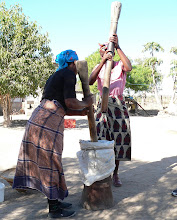 Children of Welverdiend at play, in high spirits
Children of Welverdiend at play, in high spirits(all photos and text in this post by Sally Kneidel)
Plan to spend a day in the African village of Welverdiend
An African village seeking solutions
Ecotourism can buffer the effects of poverty
We've been to a number of villages in struggling countries, but Welverdiend is special. It's the people of Welverdiend that make it so. I see that even more clearly now, after our second visit.
We went to Welverdiend initially on the recommendation of Dr. Wayne Twine, a scientist with the University of the Witwatersrand who studies the use of dwindling natural resources by rural villages near Kruger National Park. Many of the villagers have very low incomes, many are single moms, and they depend heavily on local resources that they gather themselves - branches for fuel and fencing, wild greens and fruits for food, river sand for home construction. Many of these resources are diminishing due to population growth, overharvesting by outsiders, and altered rain patterns due to climate change....brought on by industrialized nations like the U.S.
We've been to other kinds of village tours elsewhere, that turn out to be Disney-like historical displays. Fun and interesting, yes. But Ken and I are both biologists - he's a teacher and I'm a writer. When we went to Welverdiend, we wanted to know the ecological and sociological reality. How are the people of South Africa coping with diminishing resources? How are they making a living? What are their options? What are the solutions? We didn't want entertainment or historical education. I wanted the nitty gritty: what is life like here, right now? What are your current challenges and frustrations? What do you see for the future? Will you tell us honestly?
At Welverdiend, they did tell us, during both visits. Wildlife from nearby Kruger National Park and other private game reserves trample their corn, eat their crops, kill their livestock. (Many families keep chickens and a few pigs.) Gardens must be heavily fenced to keep out baboons. As passionately as I love and worry about wildlife on our planet, I learned in Welverdiend that elephants and lions and primates cause trouble for those who live with them intimately.
In addition to hearing the details about frustrations that we wanted so badly to know about, we were also warmly welcomed into the village and learned a lot about the ordinary basics of daily life. For example, we were shown how they prepare pap (the corn-based staple of their diet).
 A young woman named Celebrate (above) and her friend Virginia (below) demonstrated how the women of the village grind corn with a traditional mortar and two ironwood pestles to make mealie-meal, which when cooked yields the "pap" they eat at every meal.
A young woman named Celebrate (above) and her friend Virginia (below) demonstrated how the women of the village grind corn with a traditional mortar and two ironwood pestles to make mealie-meal, which when cooked yields the "pap" they eat at every meal. Virginia (above) sifted the ground corn into different weights, some for mealie-meal and pap, some for livestock. (More about pap preparation and diet in a later post.)
Virginia (above) sifted the ground corn into different weights, some for mealie-meal and pap, some for livestock. (More about pap preparation and diet in a later post.)A Welverdiend weaver (below) showed us how she makes sleeping mats, using stones as weights on a homemade loom.

We learned how the citizens of Welverdiend build their homes and store their grains.
 The granary above, of locally gathered wood, keeps corn and other crops out of the reach of wild animals.
The granary above, of locally gathered wood, keeps corn and other crops out of the reach of wild animals.We learned to speak a little Shangaan, the first language of Welverdiend. Xinyanyana xile nsinyeni. (Translation: The bird is in the tree.)
And we loved the traditional dances performed by the women of the village - with machetes! Their colorful clothes were fantastic.
 Masevasi led the women in traditional dances that looked like a lot of fun.
Masevasi led the women in traditional dances that looked like a lot of fun.


We had kept in touch with Welverdiend during our two-year absence, and we knew that the 17-member "co-operative" in the village was trying to increase tourism. The co-op is a core group of young adults who are energetic about seeking different options to bring much needed revenue to the village. We knew that the number of village tours had increased since our last visit, bringing in money through tour fees and giving the village women an opportunity to sell their art and crafts (below).


 The jewelry, bowls, spoons, handbags, etc., in the pictures above were made by the Women's Empowerment group in the village. More about their crafts in a later post.
The jewelry, bowls, spoons, handbags, etc., in the pictures above were made by the Women's Empowerment group in the village. More about their crafts in a later post.But in addition to more tours and more craft sales, the village had accomplished something more that was huge. Ken and I were stunned when we returned to Welverdiend to learn that the village had applied for and received a grant from the South African government to help them get started building tourist facilities and an Olympic-sized pool!
We were flabbergasted. Construction was well underway in June; phase 1 will be completed in July of 2009. Phase 1 includes the pool, a kiosk or snack shop, an amphitheater, a curio or gift shop, a reception area and office, a restaurant, and a building for "ablutions." It also includes 50 braai stands (barbecue stands) and an area for camping and picnics. Because the village is just a few meters outside the Orpen Gate into Kruger National Park, it will be easily accessible to the volume of tourists who visit South Africa's biggest park each year. The villagers also hope that the pool will be used by South Africans and by international athletes coming to train for the World Cup, to be held in South Africa in 2010. By that time, the villagers will have completed the construction of lodging for athletes on site. The grant will provide safari vehicles too, to take visitors on wildlife drives - giving the villagers added incentive to protect nearby wildlife.
One of the most exciting aspects of the new grant and construction project is that it's providing jobs for many of the villagers. In fact, most of the construction workers are single moms, for whom the income will be a tremendous boost. Added income will allow them to perhaps buy some of their fuel for cooking, reducing the pressure on overharvested village trees. I can imagine the excitement the villagers must have felt when they learned they'd been awarded this grant. I wish I could have been there.
But here's what I love most about Welverdiend. The villagers decided to hand out the highly-coveted jobs by drawing names from a basket. And it just happened that no one family got more than one job, and that most jobs went to those who would benefit most, such as single moms.
I don't see the people in Welverdiend patting themselves on the back, or bragging about their accomplishments. When things go their way, they're more likely to say, "God was with us that day." Such as the day the jobs were allotted randomly and blindly, but justly. They believe in the power of good. They believe in the capacity for change. They believe in a sustainable future.
I love them for that. I appreciate them for that, because just watching them helps me believe it too.
I'll be writing more about the people of Welverdiend in future posts, people such as Andres, a powerful and passionate spokesman for the village, and Clifford, an articulate writer who's kept in touch with friendly e-mails all these many months, and Robert, another of the co-op leaders who explains things so we can understand. I want to know Saltah better - a kind and gentle female leader in the co-op, and Nomsa, a member of the Women's Empowerment group, as well as Masevasi, the woman who leads the traditional dancing. I want to know all the people of Welverdiend better.
I'll be writing more posts about the inspiring variety of folks in this special village I've come to love, as well as our other adventures in Africa. Stay tuned. Meanwhile, if you want to tour Welverdiend and be inspired like we were, contact Dr. Wayne Twine at rcrd@global.co.za or Clifford Mathebula at blackmc@webmail.co.za. The villagers welcome families, school groups, and tourist organizations such as Elderhostel and Honeyguide. They are happy to adjust the tour to address the particular interests of each tour group. The villagers who lead the tours speak excellent English; no interpreters are needed.
All photos and text above by Sally Kneidel, PhD
Key words:: 2010 World Cup training pool in South Africa Welverdiend South Africa Kruger Park Kruger National Park village tour wildlife fuel wood sustainable natural resources resort at Kruger Park



















